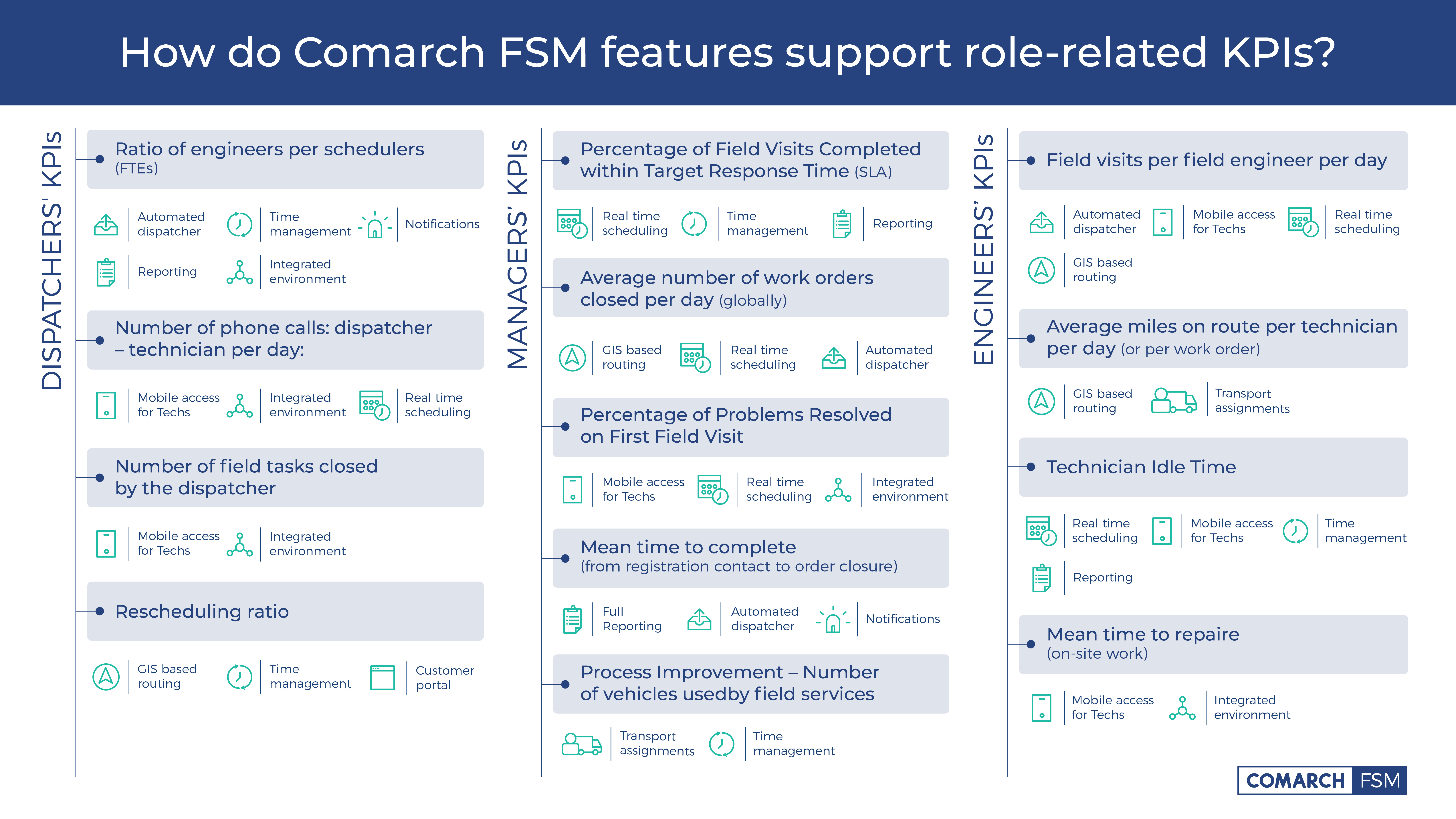18 Key KPIs to Improve in Field Service Management
- Published
- 4 min reading

Each field service metric gives you information. In theory, you can measure each aspect of your business, but in practice you need to choose what to monitor and why. But how can you identify the most crucial metrics that enable your business to grow as you expect? What areas should be monitored? How can you measure them with service management KPIs?
These questions are also valid for field operations, in the context of which we can ask how field service KPIs can be optimized.
Before you learn the most crucial KPIs for field service management, it should be mentioned that the selected areas of performance measurement are divided by role. In fact, all people in your organization, not to mention their efficiency, impact the KPIs. But, in a service organization, you also need to take into account that some unforeseen circumstances may arise, such as vehicle breakdowns, canceled appointments and employee sick leave. It is always worth considering this when carrying out analysis.
So, what key performance indicators and field service metrics should you monitor to optimize the service process?
Service management KPIs: dispatchers, schedulers, planners
Ratio of engineers to schedulers – this field service KPI is the best method to determine the planner/scheduler workload. It is a metric generally used for maintenance planning actions. For example, if this KPI amounts to 50:1, it shows that 50 technicians’ tasks can be planned by one experienced scheduler in a stable, non-reactive environment.
Number of field service tasks closed by dispatcher – even if the tasks are scheduled for each day, it doesn’t mean they will be completed – and it’s completed work that provides the measure of dispatchers’ daily effectiveness. It shows how many tasks may be completed per day by a dispatcher, even if the schedule is changed, and indicates the ability of dispatchers to manage ad hoc schedule changes.
Average number of phone calls between dispatcher and technician – by counting the average number of calls between dispatchers and technicians, you can define how much time is lost due to additional communication, and how this delays service completion.
Rescheduling ratio – the number of rescheduled tasks divided by all tasks indicates how much reactive work is needed, and indicates potential financial losses arising from lost working hours or lost customers as a result of these changes.
Manual intervention ratio - in zero-touch planning scenarios, organizations need to measure the real quality of planning engines by counting how many manual interventions are still needed to be made by dispatchers. These situations include poor planning by the engine, addressing unpredicted field events, rescheduling visits, changes in the roster, and so on. Mature planning engines based on AI/ML need to resolve issues autonomously. Engines that are poorly adapted still require a high level of dispatcher support, showing the exact points for improvement and more intelligent algorithms.
KPIs for service managers
Percentage of field service visits completed within an SLA – indicates how many field service visits are completed within the target response time. There will always be unforeseen circumstances, so achieving 100% here is impossible – but 90% is within reach. Of course, it depends on the industry and the manner of workforce management.
Average number of work orders closed per day – monitoring the average number of service visits per day and optimizing it, for example from five to six, definitely changes the overall service business operations. Having even 100 people working in the field means 100 more tasks can be completed per day. This would also impact SLA coherence and client satisfaction.
Percentage of problems resolved on first visit – by measuring the first visit success rate, a company can optimize productivity and profitability of a service business and improve its customer retention rate. By constant improvement of this field service KPI, the business is less exposed to potential lost time and resources for one-issue resolution. It is crucial to note that this rate depends on frequent technician training, an informed back office, and real-time information updates.
Mean time to complete – if the company decreases average time to complete an issue from incident reporting to resolution, it has the opportunity to complete more orders per day. To support this KPI, you need to consider all the areas that may speed up processes. These include the optimal route to each client’s premises, and effective communication of important information between dispatchers and technicians.
Number of vehicles used by field services – together with each work order assignment, you need to consider the vehicles required to get to each client’s location. When your company is able to optimize some processes, for example limiting unnecessary visits or rescheduling automatically, the result is visible not only in the lower number of employees required, but also in terms of fewer vehicles needed and decreased fuel costs.
Customer satisfaction – whenever your company is providing services to end-customers, their satisfaction is the KPI that has a tremendous impact on business operability. Satisfaction leads directly to loyalty and high customer retention, which managers fight to keep as high as possible. However, even if the service is delivered on time and is of quality, there’s always something else that can ruin your image. It is worth catching such things as early as possible, so you have a chance to adjust your actions.
Staff satisfaction – employee retention is another field service KPI that can give managers sleepless nights. In our highly competitive world, personnel must be kept motivated. High staff turnover can be influenced by plenty of factors: underpaying, lack of development, a negative working environment, or even annoying peers. Understanding their peoples’ attitudes will let managers execute countermeasures.
Visit time adherence – if something is wrong with your planning and delivery process, staff punctuality is where the impact will first come to light. Visit time adherence is a very important factor to control, as it provides a wide spectrum of business knowledge. It answers managers’ questions, such as: Is my planning feasible? Is the scope of tasks clear and doable? Is my roster properly set up with appropriate qualifications and tools? Fluctuating visit time adherence is a clear sign that the process needs adjustments.
KPIs for field service engineers, technicians and workers
Field visits per field engineer per day – by monitoring the number of field service workers’ visits per day, your company identifies the most productive workers and not necessarily the most engaged technicians. This KPI for field service workers can provide valuable information for managers, especially when they need to decide about promotions, bonuses or changes in the team. Also, when field workers know the standard number of visits, they are more motivated to reach this goal each day.
Average miles traveled per technician per day (or per work order) – well-planned visits should be optimized in terms of the distance to and between each client’s premises. The situation becomes more complicated when changes in technicians’ schedules occur. A great deal of information needs to be processed to assign a worker near the customer’s location while avoiding unnecessary costs. However, if this is feasible it can lead to significant savings in fuel costs per month and year.
Technician idle time – idle time does not mean that technicians are standing around doing nothing. It is the time spent at base, and cannot be charged out to the customer. Typically, this could be time spent locating keys or vehicles, waiting for parts, and other such issues. The monetary value of idle time can be calculated by subtracting the hours worked from the hours attended. When you factor in the labor cost per hour, you can see how many lost hours your company pays for.
Mean time to repair – this is the time needed to repair a given component or device. With this information, you can plan service visits more effectively. The factors that generally speed up issue resolution include employees’ knowledge of how to manage work orders, the necessary parts, and the quality of information provided by dispatchers.
Upsell ratio – providing a service is not always enough to stay in business. Proactiveness and upselling by your field staff who have face-to-face contact with end-customers (and know their needs and expectations) are also important. Properly trained and equipped technicians can provide added value to your sales process, shortening the path to the sale, and cutting the overall cost. That’s why it is worth focusing on KPIs for field service technicians.

With all the listed field service KPIs constantly monitored, the service delivery process may be optimized at various levels. Identifying the metrics that have the greatest negative impact on field service performance is the first step towards implementing organizational and technical changes. Each improvement should be compared with the previous results, to ensure that the company is going in the right direction.
In Comarch, for example, we have defined system features enabling specific KPIs to be optimized. It is also feasible to do the same for organizational procedures. With similar information, company managers are aware of the micro-metrics that impact the macro-metrics, and may identify even small areas for improvement. For these reasons, metrics should be used in organizations.



